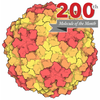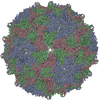+ データを開く
データを開く
- 基本情報
基本情報
| 登録情報 |  | |||||||||
|---|---|---|---|---|---|---|---|---|---|---|
| タイトル | Early disassembly intermediate of Flock House Virus | |||||||||
 マップデータ マップデータ | ||||||||||
 試料 試料 |
| |||||||||
 キーワード キーワード | Disassembly / Flock House Virus / Asymmetric reconstruction / Single Particle Reconstruction / VIRUS | |||||||||
| 機能・相同性 |  機能・相同性情報 機能・相同性情報nodavirus endopeptidase / symbiont entry into host cell via permeabilization of host membrane / T=3 icosahedral viral capsid / aspartic-type endopeptidase activity / proteolysis / metal ion binding 類似検索 - 分子機能 | |||||||||
| 生物種 |  Flock house virus (ウイルス) / Flock house virus (ウイルス) /  Flock House virus (ウイルス) Flock House virus (ウイルス) | |||||||||
| 手法 | 単粒子再構成法 / クライオ電子顕微鏡法 / 解像度: 3.1 Å | |||||||||
 データ登録者 データ登録者 | Lokshman MK / Kumar D / Borkotoky S / Banerjee M | |||||||||
| 資金援助 |  インド, 1件 インド, 1件
| |||||||||
 引用 引用 |  ジャーナル: J Mol Biol / 年: 2025 ジャーナル: J Mol Biol / 年: 2025タイトル: A Disassembly Intermediate of a Non-enveloped Virus Indicates the Pathway of Genome Release. 著者: Milan Kumar Lokshman / Kirti Suhag / Devbrat Kumar / Subhomoi Borkotoky / Manidipa Banerjee /  要旨: Disassembly of non-enveloped viruses in vivo are typically triggered by cellular factors such as host receptor binding, low pH in the early or late endosomal compartments, protease action in ...Disassembly of non-enveloped viruses in vivo are typically triggered by cellular factors such as host receptor binding, low pH in the early or late endosomal compartments, protease action in lysosomes, and localized changes in ionic concentrations. These triggers induce alterations in metastable capsids, resulting in the exposure of flexible capsid components and opening of gaps for genome release. Structural analysis of intermediate states is required to understand alterations in protein-protein and RNA-protein contacts in the pathway of capsid destabilization. Obtaining structural details of intermediates requires recreation of the in vivo transition states in stable forms, stepwise, in vitro. Here, we generated an asymmetric reconstruction of an early intermediate state in the disassembly pathway of Flock House Virus, a T = 3 icosahedral insect virus that is a model system for similar-sized non-enveloped viruses. The early intermediate was generated through judicious application, in vitro, of in vivo conditions such as receptor-binding-related transition and endosomal pH. The early intermediate showed asymmetric expansion, as well as asymmetric dynamic movement of the pocket factor, disordering of flexible membrane penetrating peptides and opening of gaps at the 2-fold axis, indicating that disassembly-related structural alterations may be local and not transpire throughout the icosahedral capsid. Surprisingly, the genomic RNA underwent a dramatic conformational alteration which superseded the relatively more subtle changes in the protein component. Recreation of disassembly-related transition states in vitro may be essential for structure-targeted, broadly effective inactivation strategies for non-enveloped viruses. | |||||||||
| 履歴 |
|
- 構造の表示
構造の表示
| 添付画像 |
|---|
- ダウンロードとリンク
ダウンロードとリンク
-EMDBアーカイブ
| マップデータ |  emd_63529.map.gz emd_63529.map.gz | 398.9 MB |  EMDBマップデータ形式 EMDBマップデータ形式 | |
|---|---|---|---|---|
| ヘッダ (付随情報) |  emd-63529-v30.xml emd-63529-v30.xml emd-63529.xml emd-63529.xml | 19.1 KB 19.1 KB | 表示 表示 |  EMDBヘッダ EMDBヘッダ |
| FSC (解像度算出) |  emd_63529_fsc.xml emd_63529_fsc.xml | 15.8 KB | 表示 |  FSCデータファイル FSCデータファイル |
| 画像 |  emd_63529.png emd_63529.png | 273.4 KB | ||
| マスクデータ |  emd_63529_msk_1.map emd_63529_msk_1.map | 421.9 MB |  マスクマップ マスクマップ | |
| Filedesc metadata |  emd-63529.cif.gz emd-63529.cif.gz | 6.1 KB | ||
| その他 |  emd_63529_half_map_1.map.gz emd_63529_half_map_1.map.gz emd_63529_half_map_2.map.gz emd_63529_half_map_2.map.gz | 391.7 MB 391.7 MB | ||
| アーカイブディレクトリ |  http://ftp.pdbj.org/pub/emdb/structures/EMD-63529 http://ftp.pdbj.org/pub/emdb/structures/EMD-63529 ftp://ftp.pdbj.org/pub/emdb/structures/EMD-63529 ftp://ftp.pdbj.org/pub/emdb/structures/EMD-63529 | HTTPS FTP |
-検証レポート
| 文書・要旨 |  emd_63529_validation.pdf.gz emd_63529_validation.pdf.gz | 1.4 MB | 表示 |  EMDB検証レポート EMDB検証レポート |
|---|---|---|---|---|
| 文書・詳細版 |  emd_63529_full_validation.pdf.gz emd_63529_full_validation.pdf.gz | 1.4 MB | 表示 | |
| XML形式データ |  emd_63529_validation.xml.gz emd_63529_validation.xml.gz | 25.3 KB | 表示 | |
| CIF形式データ |  emd_63529_validation.cif.gz emd_63529_validation.cif.gz | 33.2 KB | 表示 | |
| アーカイブディレクトリ |  https://ftp.pdbj.org/pub/emdb/validation_reports/EMD-63529 https://ftp.pdbj.org/pub/emdb/validation_reports/EMD-63529 ftp://ftp.pdbj.org/pub/emdb/validation_reports/EMD-63529 ftp://ftp.pdbj.org/pub/emdb/validation_reports/EMD-63529 | HTTPS FTP |
-関連構造データ
| 関連構造データ |  9lzlMC  9lzwMC M: このマップから作成された原子モデル C: 同じ文献を引用 ( |
|---|---|
| 類似構造データ | 類似検索 - 機能・相同性  F&H 検索 F&H 検索 |
- リンク
リンク
| EMDBのページ |  EMDB (EBI/PDBe) / EMDB (EBI/PDBe) /  EMDataResource EMDataResource |
|---|---|
| 「今月の分子」の関連する項目 |
- マップ
マップ
| ファイル |  ダウンロード / ファイル: emd_63529.map.gz / 形式: CCP4 / 大きさ: 421.9 MB / タイプ: IMAGE STORED AS FLOATING POINT NUMBER (4 BYTES) ダウンロード / ファイル: emd_63529.map.gz / 形式: CCP4 / 大きさ: 421.9 MB / タイプ: IMAGE STORED AS FLOATING POINT NUMBER (4 BYTES) | ||||||||||||||||||||||||||||||||||||
|---|---|---|---|---|---|---|---|---|---|---|---|---|---|---|---|---|---|---|---|---|---|---|---|---|---|---|---|---|---|---|---|---|---|---|---|---|---|
| 投影像・断面図 | 画像のコントロール
画像は Spider により作成 | ||||||||||||||||||||||||||||||||||||
| ボクセルのサイズ | X=Y=Z: 1.1 Å | ||||||||||||||||||||||||||||||||||||
| 密度 |
| ||||||||||||||||||||||||||||||||||||
| 対称性 | 空間群: 1 | ||||||||||||||||||||||||||||||||||||
| 詳細 | EMDB XML:
|
-添付データ
-マスク #1
| ファイル |  emd_63529_msk_1.map emd_63529_msk_1.map | ||||||||||||
|---|---|---|---|---|---|---|---|---|---|---|---|---|---|
| 投影像・断面図 |
| ||||||||||||
| 密度ヒストグラム |
-ハーフマップ: #2
| ファイル | emd_63529_half_map_1.map | ||||||||||||
|---|---|---|---|---|---|---|---|---|---|---|---|---|---|
| 投影像・断面図 |
| ||||||||||||
| 密度ヒストグラム |
-ハーフマップ: #1
| ファイル | emd_63529_half_map_2.map | ||||||||||||
|---|---|---|---|---|---|---|---|---|---|---|---|---|---|
| 投影像・断面図 |
| ||||||||||||
| 密度ヒストグラム |
- 試料の構成要素
試料の構成要素
-全体 : Flock House virus
| 全体 | 名称:  Flock House virus (ウイルス) Flock House virus (ウイルス) |
|---|---|
| 要素 |
|
-超分子 #1: Flock House virus
| 超分子 | 名称: Flock House virus / タイプ: virus / ID: 1 / 親要素: 0 / 含まれる分子: all / NCBI-ID: 12287 / 生物種: Flock House virus / ウイルスタイプ: VIROID / ウイルス・単離状態: OTHER / ウイルス・エンベロープ: No / ウイルス・中空状態: No |
|---|
-分子 #1: Capsid protein alpha
| 分子 | 名称: Capsid protein alpha / タイプ: protein_or_peptide / ID: 1 / コピー数: 6 / 光学異性体: LEVO / EC番号: nodavirus endopeptidase |
|---|---|
| 由来(天然) | 生物種:  Flock house virus (ウイルス) Flock house virus (ウイルス) |
| 分子量 | 理論値: 39.367355 KDa |
| 組換発現 | 生物種:  |
| 配列 | 文字列: MVNNNRPRRQ RAQRVVVTTT QTAPVPQQNV PRNGRRRRNR TRRNRRRVRG MNMAALTRLS QPGLAFLKCA FAPPDFNTDP GKGIPDRFE GKVVSRKDVL NQSISFTAGQ DTFILIAPTP GVAYWSASVP AGTFPTSATT FNPVNYPGFT SMFGTTSTSR S DQVSSFRY ...文字列: MVNNNRPRRQ RAQRVVVTTT QTAPVPQQNV PRNGRRRRNR TRRNRRRVRG MNMAALTRLS QPGLAFLKCA FAPPDFNTDP GKGIPDRFE GKVVSRKDVL NQSISFTAGQ DTFILIAPTP GVAYWSASVP AGTFPTSATT FNPVNYPGFT SMFGTTSTSR S DQVSSFRY ASMNVGIYPT SNLMQFAGSI TVWKCPVKLS TVQFPVATDP ATSSLVHTLV GLDGVLAVGP DNFSESFIKG VF SQSACNE PDFEFNDILE GIQTLPPANV SLGSTGQPFT MDSGAEATSG VVGWGNMDTI VIRVSAPEGA VNSAILKAWS CIE YRPNPN AMLYQFGHDS PPLDEVALQE YRTVARSLPV AVIAAQN UniProtKB: Capsid protein alpha |
-分子 #2: Capsid protein alpha
| 分子 | 名称: Capsid protein alpha / タイプ: protein_or_peptide / ID: 2 / コピー数: 6 / 光学異性体: LEVO / EC番号: nodavirus endopeptidase |
|---|---|
| 由来(天然) | 生物種:  Flock house virus (ウイルス) Flock house virus (ウイルス) |
| 分子量 | 理論値: 4.399056 KDa |
| 組換発現 | 生物種:  |
| 配列 | 文字列: ASMWERVKSI IKSSLAAASN IPGPIGVAAS GISGLSALFE GFGF UniProtKB: Capsid protein alpha |
-実験情報
-構造解析
| 手法 | クライオ電子顕微鏡法 |
|---|---|
 解析 解析 | 単粒子再構成法 |
| 試料の集合状態 | particle |
- 試料調製
試料調製
| 濃度 | 1 mg/mL |
|---|---|
| 緩衝液 | pH: 5.5 |
| グリッド | モデル: Quantifoil R2/2 / 材質: COPPER / メッシュ: 300 / 前処理 - タイプ: GLOW DISCHARGE / 前処理 - 時間: 60 sec. |
| 凍結 | 凍結剤: ETHANE / チャンバー内湿度: 100 % / チャンバー内温度: 293 K / 装置: FEI VITROBOT MARK IV |
| 詳細 | Purified wild type FHV particles were treated with low pH and incrementally heated up to 46 degree celcius. |
- 電子顕微鏡法
電子顕微鏡法
| 顕微鏡 | TFS KRIOS |
|---|---|
| 撮影 | フィルム・検出器のモデル: GATAN K3 BIOQUANTUM (6k x 4k) 平均電子線量: 39.7 e/Å2 |
| 電子線 | 加速電圧: 300 kV / 電子線源:  FIELD EMISSION GUN FIELD EMISSION GUN |
| 電子光学系 | 照射モード: FLOOD BEAM / 撮影モード: BRIGHT FIELD / Cs: 2.7 mm / 最大 デフォーカス(公称値): 2.5 µm / 最小 デフォーカス(公称値): 0.25 µm / 倍率(公称値): 81000 |
| 試料ステージ | 試料ホルダーモデル: FEI TITAN KRIOS AUTOGRID HOLDER ホルダー冷却材: NITROGEN |
| 実験機器 |  モデル: Titan Krios / 画像提供: FEI Company |
 ムービー
ムービー コントローラー
コントローラー





 Z (Sec.)
Z (Sec.) Y (Row.)
Y (Row.) X (Col.)
X (Col.)














































